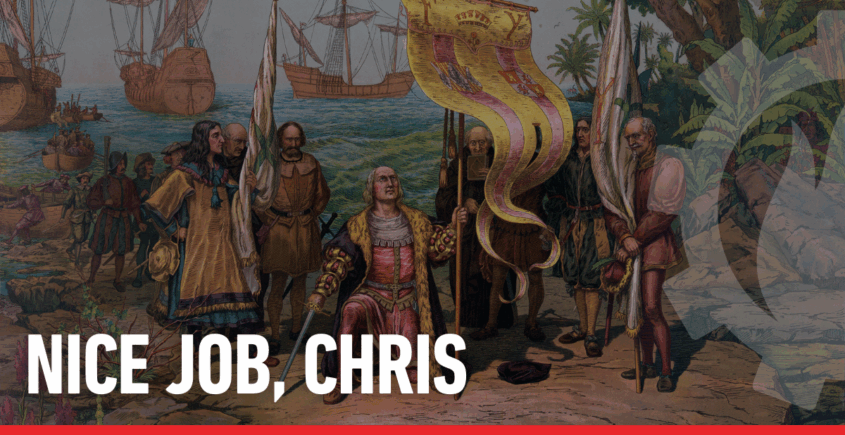Nice Job, Chris
If you’ve had the pleasure of raising kids and watching them grow up to exceed your expectations, then this story is for you. Now that our own girls have grown and found their “niche” in work, life, and the community, we’ve come to appreciate that “proud parent” feeling even more. (It even carries over into our “proud grandparent” moments as well!). On Monday, we’ll once again observe Columbus Day reflecting on the historic accomplishments of Cristoforo Colombo (he was Italian by birth, though the Spanish knew him as Cristóbal Colón). I decided to dig a little deeper into the life of “old Chris,” share a bit about his roots, and how a young man from a really modest background became one of the most famous explorers in history. With no GPS, no modern maps, and a crew full of doubts, Columbus dared to cross an uncharted ocean and opened the door to an entirely new world. Columbus Day reminds us to dream big, to explore, and to persist, even when the odds are stacked against us. Behind the well-known story is a fascinating man, some proud parents, and an incredible journey worth rediscovering. Thanks to Google and Wikipedia for the historical details. Enjoy!

Christopher (Cristoforo) Columbus was born between August and October 1451 in the Republic of Genoa, Italy, to Domenico Colombo and Susanna Fontanarossa. The Colombos weren’t wealthy or noble. Domenico was a hardworking wool weaver, small-scale merchant, and part-time tavern keeper. They were middle-class artisans living in a bustling port city filled with sailors, traders, and mapmakers – an environment that likely sparked young Christopher’s fascination with the sea.
As a boy, Columbus helped his father with the family business but spent much of his time around docks and shipyards, soaking up stories from sailors and merchants. By his teenage years, he was working on merchant ships, gaining firsthand experience in navigation, sailing techniques, and international trade.
Columbus had little formal schooling, but he was curious and ambitious. He taught himself to read, write, and study subjects like cartography, Latin, astronomy, and mathematics. He devoured works by scholars like Ptolemy and explorers like Marco Polo, becoming fascinated by the idea of reaching Asia by sailing west. Unlike many sailors of his time, Columbus combined practical maritime experience with book knowledge – a combination that gave him an edge in navigation and long-distance planning.
By his early twenties, he was sailing throughout the Mediterranean on trading voyages. In 1476, he survived a pirate attack off the coast of Portugal, swimming to shore – an experience that strengthened his fearless spirit and commitment to the sea.
After settling in Lisbon, Columbus worked as a chart maker and trader, learning about Atlantic winds, currents, and long-distance navigation. By the late 1480s, he began pitching his radical idea: to reach Asia by sailing west across the Atlantic.
In 1484, he proposed his plan to King John II of Portugal. The king rejected him, believing Columbus had miscalculated the Earth’s size and that the voyage was too risky. Columbus then approached England and France — both turned him down for the same reasons.
Finally, in 1486, Columbus turned to Spain, ruled by King Ferdinand and Queen Isabella. At first, Spain also rejected his plan, but Columbus didn’t give up. For eight years, he lobbied the Spanish court, built alliances, and waited for the right moment.
In 1492, that moment came. Spain had just completed the Reconquista and was eager to compete with Portugal for overseas trade and influence. Columbus’s proposal suddenly seemed strategic: if successful, Spain could leap ahead in accessing Asia’s spices, gold, and silk.
In April 1492, Spain agreed to sponsor Columbus under the Capitulations of Santa Fe. He would sail under the Spanish flag, receive the title “Admiral of the Ocean Sea,” and serve as Viceroy and Governor of any lands he discovered – keeping 10% of the profits (nice!). Columbus became a naturalized Spanish citizen but always considered himself Genoese at heart.
Columbus believed the fastest route to Asia was westward across the Atlantic. He thought he had reached the “Indies,” which is why the Caribbean islands were originally called the West Indies. In reality, his miscalculation of Earth’s size made the voyage far more dangerous than he realized – had the Americas not been there, his ships might never have survived.
Most of us know the Niña, Pinta, and Santa María, but those weren’t their real names: The Niña was actually named Santa Clara. The Pinta’s true name remains uncertain, as “Pinta” was just a nickname meaning “painted one” or “sassy one.” And the Santa María was Columbus’s flagship, but wrecked on his first voyage and never returned to Spain. Columbus’s favorite ship was the Niña, he used it on three of his four voyages.
Columbus’s first voyage in 1492 is famous, but he returned three more times, in 1493, 1498, and 1502. Over these expeditions, he explored parts of the Bahamas, Cuba, Hispaniola, Puerto Rico, Jamaica, Trinidad, and the coasts of Central and South America. Interestingly, Columbus never actually set foot on the North American mainland, a common misconception!
During his third voyage in 1498, when he reached present-day Venezuela, he was so struck by the area’s beauty that he believed he had discovered the Biblical Garden of Eden.
Columbus’s voyages transformed the world. He introduced Europe to foods like pineapples, cacao (chocolate), maize (corn), and chili peppers, while the New World received wheat, coffee, citrus fruits, horses, and livestock in return. This cultural exchange forever reshaped global diets, economies, and lifestyles.
The first Columbus Day celebration took place in New York in 1792, marking the 300th anniversary of his first voyage. It became a federal U.S. holiday in 1937, thanks to lobbying by Italian-American communities and the Knights of Columbus. For many Italian-Americans, Columbus Day symbolizes heritage, perseverance, and discovery.
When Columbus died in 1506, he still believed he had discovered islands near China and India – he never realized he had encountered a “New World.” Yet his voyages inspired explorers like Vasco da Gama, John Cabot, and Ferdinand Magellan to push boundaries, expand trade routes, and connect continents.
His courage can be summed up by one of his most famous quotes: “You can never cross the ocean unless you have the courage to lose sight of the shore.” How cool is that?
As we strive to solve your PIA (Pain in the @$#) Jobs!, let’s all continue to head out into the waters … Onward!






Leave a Reply
Want to join the discussion?Feel free to contribute!